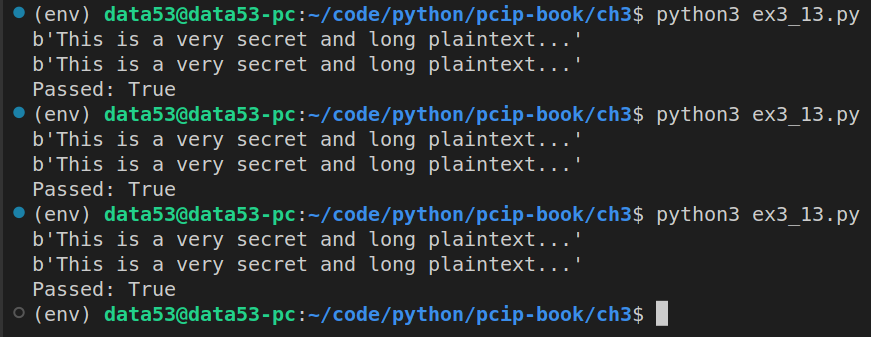3.13 WRITE A SIMPLE COUNTER MODE
EXERCISE 3.13: WRITE A SIMPLE COUNTER MODE
As you did with CBC, create counter mode encryption from ECB mode. This should be even easier that it was with CBC. Generate the key stream by taking the IV block and encrypting it, then increasing the value of the IV block by one to generate the next block of key stream material. When finished, XOR the key stream with the plaintext. Decrypt in the same manner.
# ex3_13.py
from cryptography.hazmat.primitives.ciphers import Cipher, algorithms, modes
from cryptography.hazmat.backends import default_backend
import os
AES_BLOCK_SIZE_IN_BYTES = 16
AES_BLOCK_SIZE_IN_BITS = 128
class MyOwnCTR:
def __init__(self, key: bytes, nonce: bytes):
assert(len(nonce) == AES_BLOCK_SIZE_IN_BYTES)
self.key = key
self.nonce = nonce
def encryptor(self):
return Encryptor(config=self)
def decryptor(self):
# Note that in CTR, encryption and decryption are exactly the same operations.
return Encryptor(config=self)
class Encryptor:
def __init__(self, config: MyOwnCTR):
self.config = config
self.current_nonce = self.config.nonce
self._encryptor = Cipher(
algorithm=algorithms.AES(self.config.key),
mode=modes.ECB(),
backend=default_backend(),
).encryptor()
self.e_current_nonce = self._encryptor.update(self.current_nonce)
self.buffer = b''
def update(self, plaintext: bytes) -> bytes:
self.buffer += plaintext
retval = b""
while len(self.buffer) > 0:
if len(self.e_current_nonce) == 0:
self.current_nonce = increment_the_nonce(nonce=self.current_nonce)
self.e_current_nonce = self._encryptor.update(self.current_nonce)
k = min(
len(self.buffer),
len(self.e_current_nonce),
)
retval += xor_two_byte_strings(
self.buffer[:k],
self.e_current_nonce[:k],
)
self.buffer = self.buffer[k:]
self.e_current_nonce = self.e_current_nonce[k:]
return retval
def finalize(self):
assert(len(self.buffer) == 0)
return b""
def increment_the_nonce(nonce: bytes) -> bytes:
nonce = (int.from_bytes(nonce,'big') + 1)%(2**128)
return int.to_bytes(nonce, length=16, byteorder='big')
# the following function is taken from Exercise 3.9.
def xor_two_byte_strings(x: bytes, y: bytes) -> bytes:
assert(len(x) == len(y))
result = []
for _1, _2 in zip(x, y):
result.append(_1 ^ _2)
return bytes(result)
if __name__ == '__main__':
key = os.urandom(32)
nonce = os.urandom(16)
plaintext = b"This is a very secret and long plaintext..."
my_ctr = MyOwnCTR(key=key, nonce=nonce)
my_ctr_encryptor = my_ctr.encryptor()
my_ctr_decryptor = my_ctr.decryptor()
ciphertext1 = my_ctr_encryptor.update(plaintext)
print(my_ctr_decryptor.update(ciphertext1))
official_ctr = Cipher(
algorithm=algorithms.AES(key),
mode=modes.CTR(nonce),
backend=default_backend(),
)
official_ctr_encryptor = official_ctr.encryptor()
official_ctr_decryptor = official_ctr.decryptor()
ciphertext2 = official_ctr_encryptor.update(plaintext)
print(official_ctr_decryptor.update(ciphertext2))
print(f"Passed: {ciphertext1 == ciphertext2}")And that is how we create our own CTR mode from ECB mode.
Note that in the above code we didn’t need padding of the plaintext.
When we run the above code we get the following:
